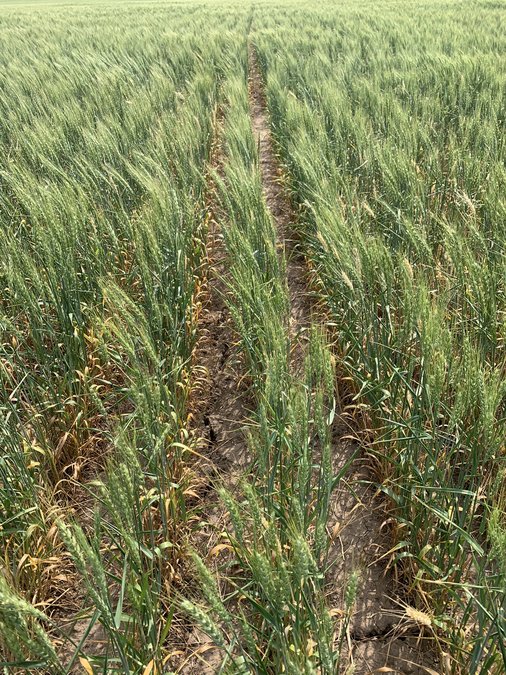MANHATTAN — A panel of participants from up and down the supply chain in the wheat industry will get a first-hand look at what many Kansas producers have known for some time.
It’s really dry out here.
The 2022 Wheat Quality Council Winter Wheat Tour will traverse the state on predetermined routes beginning in Manhattan, out to Colby and Wichita and back to Manhattan by Friday this week. Some of this year’s routes will include counties in Nebraska and Oklahoma.
Daily wrap-ups will be shared on Twitter at #WheatTour22 and in nightly email newsletters during the tour. A couple of tour groups had Rice and Barton counties on their routes as the cars headed out.
More than 60 years ago, the Wheat tour began as a way to educate millers and bakers on winter wheat production. Today, the group includes farmers, grain traders and others.
For some, it will be the first time they have set foot in a wheat field. Last year, about 45 people from 13 states made the 63rd annual tour; nearly half had only seen the Kansas plains from the window seat of a passing airplane.
On the tour, participants are shown how to make yield estimates that are calculated from area field samplings. The individual estimates are averaged with the rest of their route mates and eventually combined to produce a final yield estimate.
The tour not only spotlights the potential yield for the upcoming harvest, but also gives farmers the chance to interact with their customers along the “grain chain.”
Reaching the center
Cars along one of the routes reached fields near Hoisington Tuesday morning in the center of the Golden Belt, reported Dave Green, executive vice-president of the Wheat Quality Council. Green assembles the tour routes for the Hard Winter Wheat portion in May, which annually puts dozens of vehicles on the road prior to harvest season.
In Green’s group on Tuesday, Rice County fields were showing harder drought stress after a string of dryland fields averaging 66 bushels per acre, down to between 30-33 bpa, with large soil cracks. Just shy of Great Bend along U.S. 56 was a field that averaged 47 bpa.
“It’s been an up-and-down day,” Green said. “It is definitely looking drier as we are moving west.” Green was on the road back toward Plainville on U.S. 183 by mid-afternoon.
Hand-holding a stunted wheat crop
As they move west, groups expect to see quite bit of wheat in drought stress.
According to Mary Marsh, communications assistant with Kansas Wheat, much of southwest Kansas has gone 300 days without an inch of precipitation. This includes less than an inch since wheat was planted in the fall.
Marsha Bosewell, Kansas Wheat vice-president of communications, noted that farmers in several counties in the far southwest corner of the state have already contacted crop adjusters, as fields are adjusted from zero to five bushels per acre.
For those farmers who did have some precipitation, high input prices have restricted fertilizer and fungicide applications. Some are facing the decision whether to destroy the emerged wheat and plant grain sorghum in the exceptionally dry conditions — or leave what has come up in place to keep soil from blowing in daily winds up to 70 miles per hour.
With the current global upheaval in the wheat markets spiking wheat prices, participants are more interested than ever in observing the crop and its pre-harvest potential.
Tracking the decline
Based on May 1 conditions, Kansas’s 2022 winter wheat crop was forecast at 271 million bushels, down 26% from last year’s crop, according to the United States Department of Agriculture’s National Agricultural Statistics Service. Average yield was forecast at 39 bushels per acre, down 13 bushels from last year.
Acreage to be harvested for grain was estimated at 6.95 million acres, down 50,000 acres from last year. This would be 96% of the planted acres, below last year’s 94% that were harvested.
By May 15, Kansas wheat conditions continued to deteriorate. The crop condition was rated 41% poor to very poor, 35% fair, and 24% good to excellent, according to USDA/NASS.
Kansas winter wheat jointed was 93%, near 95% from last year. Headed was 60%, ahead of 54% last year, and near 58% for the five-year average, according to USDA/NASS.
In the Golden Belt, 98% was jointed and 74% headed.
Early reports
Some early reports filtered in on Twitter from the first day. In Clay County, wheat looked decent from the road, but showed drought stress on closer inspection. Bushels per acre varied from 45 to 35.
Recent rains along the northern tier weren’t enough to affect a yield increase.





